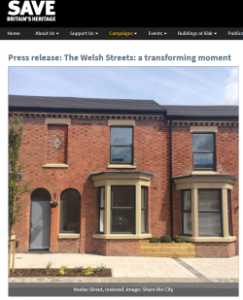 Prolonged battles by SAVE and partners to prevent the needless and wasteful destruction of tens of thousands of decent terraced houses in the north of England has received triumphant vindication with the opening in August 2017 of the first restored houses in Liverpool’s Welsh Streets.
Prolonged battles by SAVE and partners to prevent the needless and wasteful destruction of tens of thousands of decent terraced houses in the north of England has received triumphant vindication with the opening in August 2017 of the first restored houses in Liverpool’s Welsh Streets.
SAVE writes:
This has been the fiercest and most intense battle SAVE has ever had to fight, aimed at halting the infamous 2005 ‘Pathfinder’ policy dubbed, ‘bulldoze the north and concrete the south’. Up to 400,000 homes across the north of England and Midlands were targeted for demolition, 18,000 of them on Merseyside. Many terraces were demolished, but others were left derelict when the policy was abandoned as a failure in 2011, including Liverpool’s Anfield, Granby and the nearby Welsh Streets.
The restoration and revival of the Welsh Streets has been undertaken by Manchester-based house builders PlaceFirst. The first batch of newly completed houses ingeniously offers a variety of homes within the walls of the existing terraces. Four bedroom houses have been created by linking two neighbouring houses. In other cases three houses have become two – each with three bedrooms. Other houses have been restored as two and one bedroom accommodation.
Facades have been restored with careful attention to original detail and features. There are generous pavements, good paving and new street trees. The demolition of rear wings (outriggers) has brought much more light into the back of the houses.
SAVE Director Henrietta Billings says: ‘It’s fantastic to see these houses brought back to life – in a way that shows how versatile terraced houses can be. It smashes the myth that this type of housing was beyond its sell by date – and shows what persistent campaigning by us and many groups and individuals can achieve. The terraces have been updated and adapted, while keeping the human scale and character of the 19th-century streets and celebrating this part of Toxteth’s history.’
SAVE Executive President Marcus Binney says: ‘We have spent 13 agonising years publishing reports, fighting planning enquiries, supporting and initiating legal challenges, and watched the evictions of numerous families fighting to stay in their homes. The lost houses of Anfield, Bootle, Edge Lane and Gateshead are etched in our memories as it has now been proved they need never have been demolished and could have been refurbished at reasonable cost as much needed homes.’
SAVE Liverpool representative Jonathan Brown says: ‘By proving once again that historic inner cities remain popular and even futuristic, and not ‘low demand and obsolete’ as claimed by devotees of demolition, the renovated Welsh Streets will stand as a shining example of creative reuse against the cult of comprehensive redevelopment and the miseries of managed decline. Over 13 years, such determined lobbying has had a transformational effect on the place of terraced housing in the national discourse, moving it from obsolete slum in the eyes of some, to – in the case of Granby Street – a Turner-Prize-winning treasure.’
SAVE’s long term campaign-work helped connect isolated residents across pathfinder demolition zones and build a platform on which their concerns could attract national attention. Jonathan Brown led much of this bridge building, working to advocate street level campaigns to national policy makers, drawing legal and media firepower to their cause. Jonathan wrote many of SAVE’s numerous planning interventions, building the case for the public inquiry, which ultimately saved the homes and re-set national regeneration policy.
